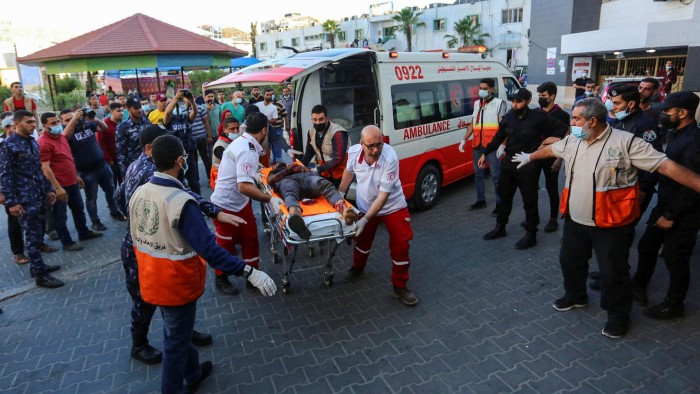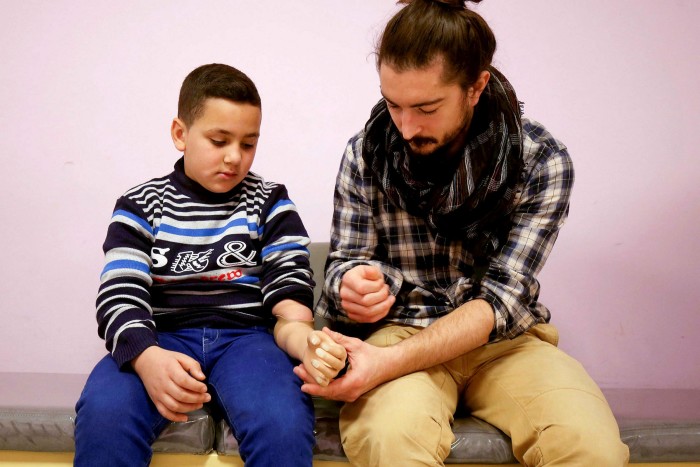Drug-resilient bacteria threat rises with spread of world’s war zones

Roula Khalaf, Editor of the FT, selects her favourite stories in this weekly newsletter.
Tom Potokar recalls patients at Shifa hospital in Gaza returning for consultations after limb surgery to remediate gun and bomb injuries. Their apparent recovery belies dangerous underlying infections — part of a growing trend as conflict spreads from the Middle East into Ukraine and beyond.
“They are wandering around on crutches and not at death’s door,” says Potokar, chief surgeon at the International Committee for the Red Cross. “But their wounds are not healthy: the edges are broken down and pus is leaking out. You know that’s a major issue. Often, it can look like nothing too much, but it’s a bit like an iceberg.”
He has been forced to provide extensive follow-up treatment, reopening and cleaning wounds and prescribing powerful antibiotics to tackle infections that can prove lethal to the patients and transmissible to others.
Potokar is one of an increasing number of medical specialists alarmed by an emerging pattern of drug-resistant bacteria spreading within, and beyond, war zones.
While the topic is still poorly understood, there is increasing evidence that war is concentrating and magnifying many of the factors that contribute to the “silent pandemic” of antimicrobial resistance. It kills more than 1mn people a year around the world.
There have long been anecdotal reports of distinctive drug-resistant bacteria in patients in conflict zones — not least acinetobacter baumannii, dubbed “Iraqibacter” and identified in wounded US troops treated in the Gulf wars. Now, confirmatory evidence is coming from elsewhere.
“The Middle East is probably the hotspot globally for AMR,” says Potokar, whose patients have included Palestinians wounded by shots from high- velocity military weapons as well as by knives and guns as part of intercommunal violence. “It is undoubtedly a significant problem.”
Research at an ICRC reconstructive surgical project in Lebanon showed that patients admitted during 2016-19 presented with a high proportion of multidrug-resistant bacteria in samples taken from their skin, soft tissue and bones.
Médecins Sans Frontières, the medical charity, operates a regional reconstructive surgery programme in Amman in Jordan for patients wounded in conflict in Iraq, Syria, Lebanon, Yemen and Palestine. It reports that more than half of its patients arrive with chronic infections, of which more than 60 per cent are multidrug-resistant.
Antoine Abou Fayad, an assistant professor at the American University of Beirut, says he began studying the phenomenon in 2018. He has since analysed samples from patients in a number of conflict-torn countries in the region, including Syria, Libya and Iraq.

“We noted infections that were not typical for AMR in non-conflict zones,” he says. “There were weird patterns — and not just of one strain — that you would not normally see in patients in Europe, the US or Australia.”
He points to the interaction between these bacteria and heavy metals such as copper, lead and zinc. These are present in bullets, shells and also construction materials released into the environment when buildings are bombed.
Potokar says the deep penetration of powerful bullets exposes the body to particular risks of infection, as it causes substantial internal damage and creates a vacuum that draws in contaminants.
Beyond the direct cause of the wounds, poor hygiene during treatment is a further contributing factor. Conflict injuries often occur far from medical facilities, requiring patients to be transported over many hours or days without adequate time to clean, dress or treat their wounds.
Even in more stable medical centres away from the battlefront, inadequate infrastructure such as poor water supply or sewage facilities can accentuate the problem.
A study led by health specialist Reem Tawfeek Abu Shomar-Alyazouri identified that more than a third of swabs taken from water and surfaces in two Gaza hospitals contained high levels of bacterial contamination.
As in other parts of the world, treatment centres can lack access to reliable diagnostics and effective, safe and appropriate antibiotics. Patients may take — even without prescriptions or specialist supervision — unsuitable drugs, courses of treatment that are too short, or medicines that are expired, substandard or fake. These are all factors driving AMR.
A study published last year by Hattie Lowe at the London School of Hygiene and Tropical Medicine — with staff at ICRC centres in the Central African Republic, South Sudan, Democratic Republic of Congo, Mali, Nigeria, Lebanon, Yemen and Afghanistan — identified a series of risks.
Among them were inadequate hospital infrastructure, resource and workforce shortages, lack of staff education, poor training and supervision, and large visitor numbers, as well as supply chain disruptions, high infection rates, and direct attacks on healthcare infrastructure.
Claudia Truppa, ICRC’s health co-ordinator in Lebanon, says: “When a conflict arises, on top of pre-existing drivers for AMR, you get additional disruption. The more experienced medical personnel often flee and, for others, there is reduced training.” Her agency is developing new approaches, including deploying more specialist surgeons.
Understanding the links between warfare and AMR requires more research, though.
Dr Aula Abbara, an infectious disease consultant and co-chair of the Syria Public Health Network, has long called for measures to improve training, surveillance and access to appropriate drugs.
“Eight years ago, when we started, I felt I was imposing it,” she says. “But pressure is coming from the doctors working in the field, who say they are experiencing treatment failures from the war wounded and even those not associated with conflict.”

Comments